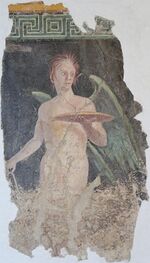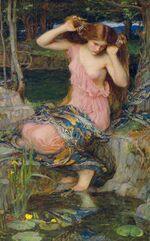Social:Geniscus

Geniscus[needs IPA] is a deity who appears in a sermon of Saint Eligius along with Neptune, Orcus, Minerva and Diana. These are all, the Christian homilist says, "demons" who should not be believed in or invoked.[1] The warning implies cult activity for these deities in the northern parts of Merovingian Gaul into the 7th century.[2]
Geniscus may be a form of reference to the Genius, the Roman tutelary deity; in Gaul, the Genius is often hooded (Genius Cucullatus) and appears either singly or in a group of three.[3]
In another sermon in the same period, the Geniscus appears in the company of witches (striae) and other entities in whom "rustics" believe:[4]
| “ | There are some country people (rustici homines) who have a belief in certain women, because it is commonly said that they must be witches and able to harm infants and cattle, and the Dusiolus or Aquatiquus[5] or Geniscus must too.[6] | ” |
19th century

The 19th-century fascination for folklore, antiquarianism, the supernatural, and lost religions drew attention to even the obscure Geniscus. The Irish folklorist Thomas Crofton Croker accepted a derivation of geniscus from Latin genius and in his chapter on elves declared the geniscus "a real Elf, or spirit of light." Croker further connected geniscus to the geniciales feminae[7] named by Hincmar, a 9th-century archbishop of Reims, who identified the geniciales as lamiae.[8] During the same period Jacob Grimm classed the geniciales among the "daemonic elvish beings, who appeared in woman's shape and did men kindnesses," and who participated in elf-dance: "To christian zealots all dancing appeared sinful and heathenish, and sure enough it often was derived from pagan rites, like other harmless pleasures and customs of the common people, who would not easily part with their diversion at great festivals." Grimm connects these dances to bonfires.[9]
Geniscus is mentioned in the 1876 historical fiction Dante and Beatrice from 1282 to 1290: A Romance by Elizabeth Kerr Coulson, writing under the pseudonym Roxburghe Lothian. Coulson recounts at length the Christian prohibitions that a friar called The Hermit must enforce, then segues into practices deemed tolerable:
| “ | He had to stop people from keeping the day of rats and mice;[10] a day which, with many similar remnants of paganism, the Church had forbidden, although she had been pleased to appoint Saint Gertrude of Nivelle, as the patroness of their destruction. He was also bound to decry the old reverence for ash trees,[11] which reverence was a relic of the pagan Solstitia. He would tolerate no June fires, on the even of St John, neither any dancing around them. But, on the other hand, there were minor customs of the lowliest of the poor which he tolerated. Such were the lighting of small cressets to float on streams and fountains, to prevent their drying up (which same were of old offerings to the Naiads and Potamides[12]); hanging of wreaths of vervain round the necks of beasts to keep adders from them; placing of sprigs of box over cottage doors; wearing pieces of amber for Minerva, and strange amulets against Ouragus,[13] the old god of death, and his helper Geniscus; treasuring of red pebbles, found in the marsh-lands, in lap-wings' nests. These, and many more customs of the same kind, he found ineradicable, and was fain to tolerate patiently.[14] | ” |
Whether she used the Vita of St. Eligius directly or another source such as Croker, Coulson preserves the collocation of Geniscus with Minerva and Orcus (here Ouragus[15]). She either innovates or draws on traditions pertaining to the cult of the Genii by making Geniscus the "helper" of Orcus.
References
- ↑ Vita Eligii 9 (c. 700–724), MGH SRM 4: 705–706, as cited by Bernadotte Filotas, Pagan Survivals, Superstitions and Popular Cultures in Early Medieval Pastoral Literature (Pontifical Institute of Mediaeval Studies, 2005), p. 78. English translation by Jo Ann McNamara of Dado of Rouen's Life of St. Eligius of Noyon in Medieval Hagiography: An Anthology (Routledge, 2001), pp. 137–168, with reference to Geniscus p. 157 online. See also Mythology in the Low Countries.
- ↑ Filotas, Pagan Survivals, p. 79.
- ↑ Filotas, Pagan Survivals, p. 79.
- ↑ Filotas, Pagan Survivals, p. 79.
- ↑ Aquatiquus from aqua, the "Watery One."
- ↑ Sunt aliqui rustici homines, qui credunt aliquas mulieres, quod vulgum dicitur strias esse debeant, et ad infantes vel pecora nocere possint, vel Dusiolus vel Aquatiquus, vel Geniscus debeant as quoted by Du Cange in his 1678 Glossarium mediae et infimae latinitatis (Niort: Favre, 1883–1887), vol. 4, online.
- ↑ Thomas Crofton Croker, Fairy Legends and Traditions of the South of Ireland (London, 1828), p. 127 online.
- ↑ Hincmar, De divortio Lotharii ("On Lothar's divorce"), XV Interrogatio, MGH Concilia 4 Supplementum, 205, as cited by Filotas, Pagan Survivals, p. 305. In compiling his 1628 Glossarium, Du Cange made note of the geniciales feminae, and although he appears to have associated them with words pertaining to generation and genitalia, he makes no explicit connection to Geniscus; see entry on geniciales feminae online.
- ↑ Jacob Grimm Teutonic Mythology (London, 1883), vol. 3, p. 1056 online.
- ↑ This reference requires elucidation; perhaps Coulson means the Norman agricultural rite when animals injurious to crops were exorcized during the season of Advent; children brandished torches through the fields and chanted Mice, caterpillars and moles, / Get out, get out of my field; / I will burn you beard and bones. / Trees and shrubs, / Give me bushels of apples; see Encyclopaedia of Superstitions, Folklore, and the Occult Sciences of the World (Chicago, 1903), vol. 3, p. 1479 online. But this is conjecture, and a number of other rites or occasions may be meant; the Pied Piper of Hamelin may also come to mind.
- ↑ See also World tree, Tree of life, Maypole, Tree worship, Yggdrasil, Thor's oak, Irminsul, and Sacred tree at Uppsala.
- ↑ Daughters of Potamus ("River").
- ↑ Coulson's source for this form of the theonym Orcus is unclear.
- ↑ Elizabeth Kerr Coulson writing as Roxburghe Lothian, Dante and Beatrice from 1282 to 1290: A Romance (London, 1876), vol. 1, pp. 117–118; full text downloadable.
- ↑ This is a rather learned allusion on the part of the author, as Uragus is a form given by Festus as the original from which Orcus derived; see Actes del IXè Simposi de la Secció Catalana de la SEEC St. Feliu de Guíxols, 13–16 d'abril de 1988: Treballs en honor de Virgilio Bejarano (Barcelona, 1991), p. 186 online.
 |
